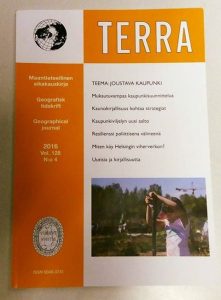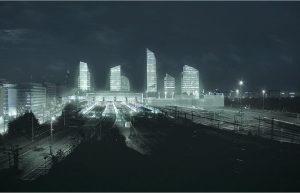Out now: a themed issue on the “Resilient City” (“Joustava kaupunki”) in the Finnish geography journal Terra (2016/4).
Visiting editors-in-chief: Lieven Ameel (University of Tampere), Salla Jokela (University of Helsinki), Aura Kivilaakso (University of Helsinki), Silja Laine (University of Turku) & Tanja Vahtikari (University of Tampere).
Link to the introduction (in Finnish)
https://blogs.helsinki.fi/urbannarratives/files/2015/03/Terra_johdanto.pdf
The issue includes a refereed survey article by Aleksi Neuvonen and myself on visions of the future in urban planning and literary texts
https://blogs.helsinki.fi/urbannarratives/files/2015/03/Terra_Ameel_Neuvonen.pdf

From the introduction:
”[T]eemanumero lähestyy resilienssin käsitettä sekä kaupunkien muuntautumis- ja sopeutumisvalmiutta kilpailukyvyn, kaupunkivisioiden, kaavoituksen ja kaupunkilaisten osallisuuden näkökulmista. Julkaisu valottaa ajankohtaista kansainvälistä keskustelua kaupunkien resilienssistä tarjomalla siihen vahvasti historian- ja kulttuurintutkimukseen sidotun näkökulman, joka osaltaan kyseenalaistaa urban resilience -käsitteeseen liitettyä infrastruktuuri- ja teknologia-painotteista retoriikkaa. Teemanumeron kirjoitukset on pääosin laadittu Tampereella 11.–12. toukokuuta 2015 järjestetyillä Kaupunkitutkimuksen päivillä pidettyjen esitelmien pohjalta.”

